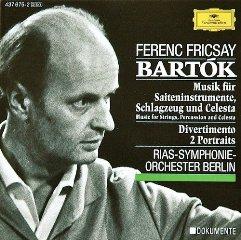Bela Bartok - Music for Strings, Percusion & Celesta (Fricsay) [1993]
Bela Bartok - Music for Strings, Percusion & Celesta (Fricsay) [1993]

Music for Strings, Percusion & Celesta 01 - I. Andante tranquilo 02 – II. Allegro 03 – III. Adagio 04 - IV. Allegro molto Divertimento for String Orchestra Sz 113 05 - I. Allegro non troppo 06 - II. Molto adagio 07 - III. Allegro assai Two Portraits 08 – I. Andante 09 – II. Presto RIAS Symphonie-Orchester Berlin Ferenc Fricsay – conductor
The Music for Strings, Percussion and Celesta was commissioned in 1936 by Paul Sacher for the Basle Chamber Orchestra, and marked Bartók’s return to full-scale abstract orchestral composition following a period of close involvement with folk music and the composition of the fifth string quartet. The title is slightly misleading, in that the celesta is not of significantly greater importance than the other tuned percussion instruments chosen by the composer; piano, harp, xylophone and timpani. These are placed between what effectively amounts to two quite separate string orchestras on opposite sides of the platform, thus emphasising both the spatial and symmetrical potentialities of the music. ---bhco.co.uk
Divertimento for string orchestra, Sz. 113, BB 118. This 1939 work marks the end of Bartok's European career. It was composed on commission from Paul Sacher, the pioneering conductor who commissioned so much fine music for his string orchestra in Basle, Switzerland. Bartok was then already planning to move to the United States to escape both the gathering war clouds of Europe and the Nazi sympathizing regime of his native Hungary. He had already sent his manuscripts and papers to London, but remained at home because of the terminal illness of his mother. While taking a break from all this he visited Sacher in Switzerland and while there composed this substantial (nearly 25 minute) work in 15 days. His mother died in December; Bartok finished up his personal affairs in Europe, giving his farewell Budapest appearance in October 1940. Meanwhile, the Divertimento had been successfully premiered in June in Basle. ---Joseph Stevenson, Rovi
The Portraits (2) for Orchestra are not original compositions as such, but actually modified versions of two other works by Bartók. The first Portrait is the first movement of his First Violin Concerto, which was only published posthumously; Bartók withdrew it in 1907 before its premiere. The second Portrait is an orchestrated version of the fourteenth of the Fourteen Bagatelles for piano (the piano version was composed in 1908, but was not orchestrated for the Portraits until 1911). ---Alexander Carpenter, Rovi
download: uploaded anonfiles mega 4shared mixturecloud yandex mediafire ziddu
Last Updated (Monday, 19 August 2013 19:54)








